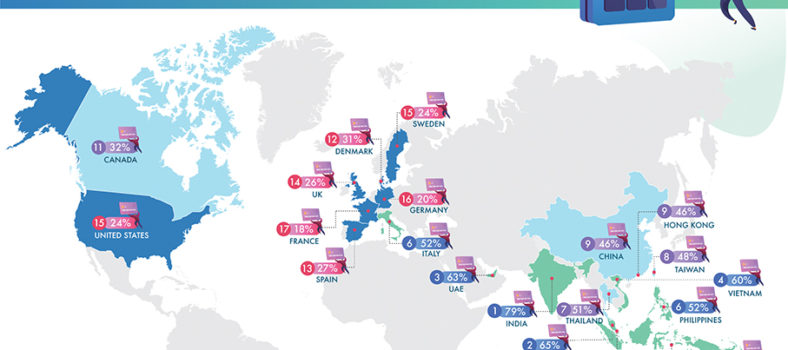 By Chris Catliff
By Chris Catliff
The past 12 months have been a crash course in disruption. The global pandemic has affected every industry, every country and every person. I have seen many ups and downs in the financial services industry during my 21-year tenure as CEO of BlueShore Financial, a boutique full service financial institution in Vancouver, BC, but the tests presented by COVID-19 are a first.
The pandemic has been a significant catalyst for change. It brought unparalleled challenges for the financial services industry; however, it also positively accelerated the drive to develop new digital operating models, upskill workforces, and re-examine risk management playbooks. COVID-19 fast-tracked disruption by about a decade. What does this mean for future trends in Canadian banking?
A digital-human hybrid
A 2019 Wells Fargo report predicts that 200,000 banking jobs in the US will be lost to automation and artificial intelligence in the next ten years. I expect a similar phenomenon will occur in Canada. As COVID-19 led to a cross-sector working-from-home ‘revolution’, as well as the temporary or permanent closure of many businesses, the news of financial services’ branch closures hit the headlines on a regular basis. But, I do not believe that the future holds a total closure of bricks and mortar businesses. While industries, including financial services, need to evolve and up their digital game, when it comes to people’s finances, the need for connection and human touch endures.
Business intelligence, data, and artificial intelligence undoubtedly play a significant role in the financial services industry and will continue to do so in the future. Yet, there are elements of client servicing and care that “bots” simply cannot offer. Robo-technology cannot account for the whole person nor alleviate a client’s deep felt anxiety. Human advisors provide expertise, trust, and comfort when dealing with topics as emotional as one’s finances and security, particularly in times of global uncertainty.
For example, in our 2020 BlueShore Financial Client Experience Survey, 62 percent of clients said their preferred method of interaction with their advisor is still a face-to-face meeting. While everyday banking is well suited for online transactions, intricate and complex financial discussions such as planning for retirement, intergenerational wealth transfer, or a child’s down payment on their first home, often require face-to-face, personalized advice from a professional.
However, digital advancements will certainly continue to change the way financial advisors interact with their clients. At BlueShore, our strategy encompasses a “high-tech, high-touch” approach. In other words, we use technology to seamlessly enhance and strengthen, rather than replace, our deep relationships with clients. Today, clients say, “show me you know me.” With this in mind, we gather and harness data and use AI to provide personalized experiences and predict products and services clients may need, before they ask for them.
Technology provides convenience and efficiencies, but there are times when human connection and expertise reign, so a digital-human hybrid model is something most financial institutions should work towards.
Why not just do it all over Zoom, you ask? The pandemic has triggered new studies finding on-screen eye contact is very different to direct in-person eye contact. In-person eye contact divulges much of true intention and therefore trust, but this cue is most often missed in digital communication. Simply put, they may watch your face and you may watch theirs, but you do not look into each other’s eyes. Often, we look not at the other person but at the picture of ourselves.
In addition, with digital-only communication, we miss the benefit of seeing one another’s body language. Face-to-face communication provides clear intention through body language and facial expression, and this is critical in providing reassurance. Reducing communication to two-dimensional faces means we miss non-verbal cues, complex nuances, and the mini-expressions required for meaningful communication.
It’s true that as clients become more comfortable with online and digital banking options, the need for a large amount of bricks and mortar real estate will likely lessen for the financial services industry. It will not however, diminish completely. In fact, many branches were already shifting from fewer teller “transactions” to more “advice-giving” in their function and design. With the savings from a few select branch closures, financial institutions can invest further in their digital strategy to provide a more seamless digital and human hybrid experience for clients. Going forward, financial institutions that do not embrace digital disruption and technology advancements will be left in the dust.
Upskilling from the inside
The global pandemic has shown senior leaders that finding new ways to build business resilience is critical for survival. With technology rapidly evolving, the way we work is changing, and organizations of all sizes must adapt and address workforce challenges and opportunities now, to future-proof themselves for later. Foundational to success here, is developing talent from the inside.
A recent PwC survey observed that 75 percent of Canadian CEOs are concerned about the availability of key skills in relation to their growth prospects. According to the same survey, many CEOs have also admitted they’re behind in establishing upskilling programs that focus on developing a mix of soft, technical and digital skills.
With the battle for top talent ongoing, now is the time to focus on retraining and upskilling the employees you already have to help drive innovation and growth, moving forward. Even if your organization has implemented new technology, it will only be as good as the employees who are able to successfully operate it, explain it, and use it to its full potential.
While being tech savvy and having digital acumen are important skills to have, it doesn’t end there. The “softer” skills that organizations need, such as creativity, empathy, problem solving and leadership, are the traits that will help employees to think, act and flourish in an unpredictable and rapidly digitizing world. Talent remains key to strategic success today and in the future. Financial institutions will need to encourage and support further learning and development at all levels in order to thrive.
Examples of upskilling from BlueShore Financial include our yearlong executive leadership development program that provides our management level employees with the skills required to successfully coach and lead their teams, particularly in the digital era. We have also implemented a Digital Ambassador program, whereby representatives from across the organization test new software and equipment before it is introduced to the broader organization. They become the experts within their teams to aid with the associated roll-out and change management in their areas.
Reviewing and adapting to risk
The COVID-19 pandemic has paradoxically reminded us to be prepared for uncertainty. Businesses of every kind need to evaluate their risk exposure for possible unforeseen and unprecedented events.
The good news for organizations with strong crisis management plans in place is that the pandemic has thoroughly tested these plans and shown any gaps using real and timely information. Now is the opportune moment to fine-tune these plans and incorporate lessons learned from your pandemic response. On the flip side, if the pandemic hit and your organization’s crisis plans were stale or outdated, consider yourselves reminded of the criticality of creating and updating these plans regularly, and of fire-walling your data.
As digitization and remote work rapidly accelerated in 2020, traditional network perimeters and boundaries between work and home life blurred. For many financial institutions, this was the first time employees were permitted to bring technology equipment home and access the corporate network remotely. Because cyber-criminals are especially active in times of global uncertainty, the need for increased diligence and cyber-security awareness is high. Hackers and cyber scammers are continuously trying to take advantage of the remote worker.
Financial institutions need to continually evaluate risk exposure for the next unforeseen event. An additional area of focus for FIs is to review the diversification of your clients’ portfolios. While the goal of diversification is to prepare for market volatility, a good practice is to evaluate clients’ portfolios through the lens of their recent experience during the pandemic. Is the risk tolerance level still appropriate? Should it be lowered due to new financial strains or goals? Should it be increased in light of lower income and interest rates? The answers will depend on the client’s personal preferences, life stage, acceptance of a lower goal at retirement or acceptance of delaying their retirement. While these factors are traditionally evaluated regularly, the pandemic necessitates a deeper review of the client’s full financial picture, layered with more empathy than a robo-advisor can be programmed for. Re-built confidence about your future prospects from a newly-trusted advisor is worth the time of a branch trip.
Moving forward, branches will not obsolete, but those who solely rely on them will be. In the future, the biggest bang will come from those institutions who create seamless banking experiences using the best “TNT” (talent and technology).
Chris Catliff is President & CEO, BlueShore Financial. A 30 year veteran of the financial services industry, Chris Catliff has been the CEO of BlueShore Financial since 2000. As CEO, he has led the organization’s successful rebranding, technological innovation, and strong organic growth, including Assets Under Administration reaching $6.5 billion. Chris has a broad experience in leading and developing financial institutions through an emphasis on innovative service, engaged employees and premium client service.




